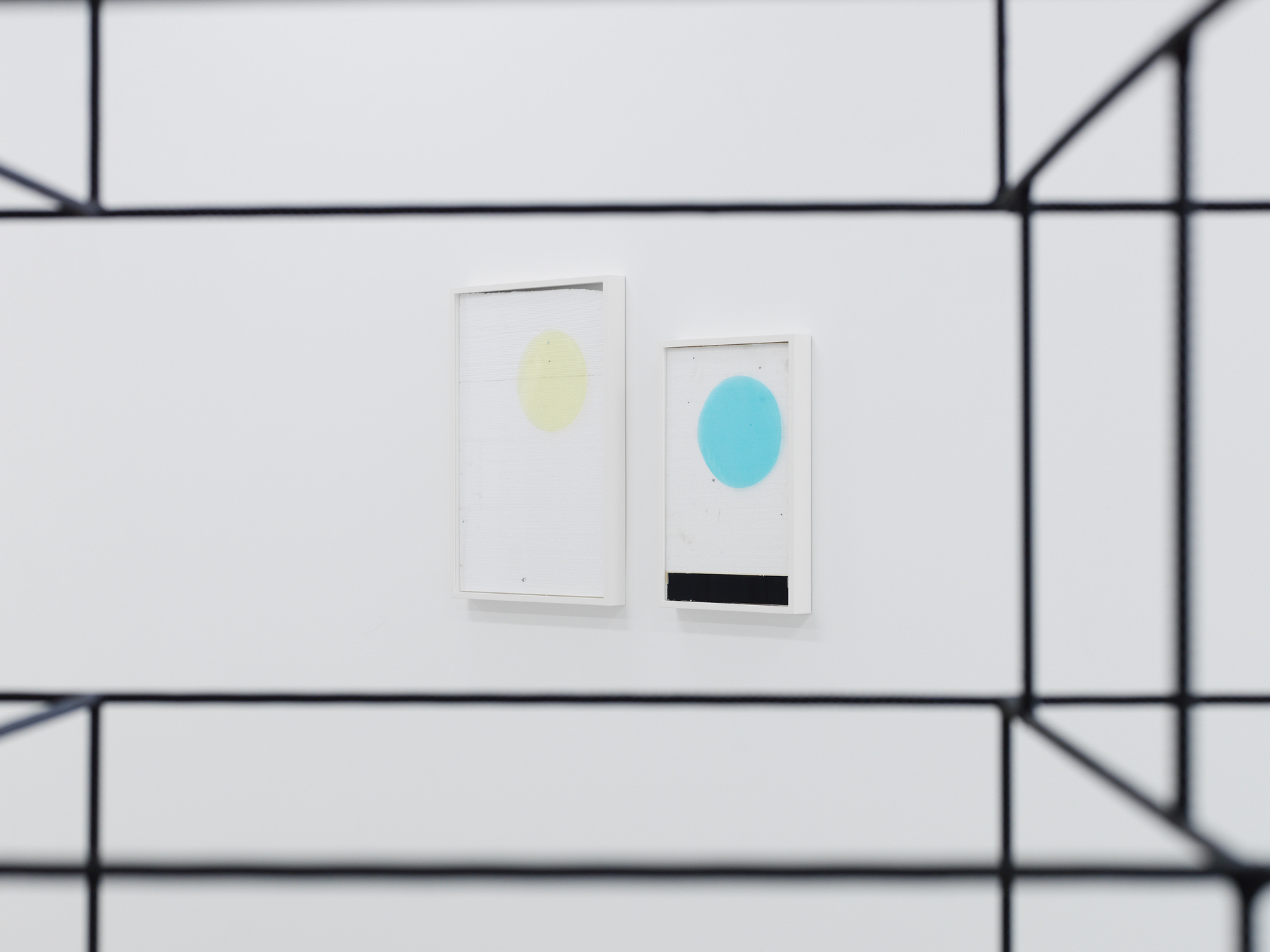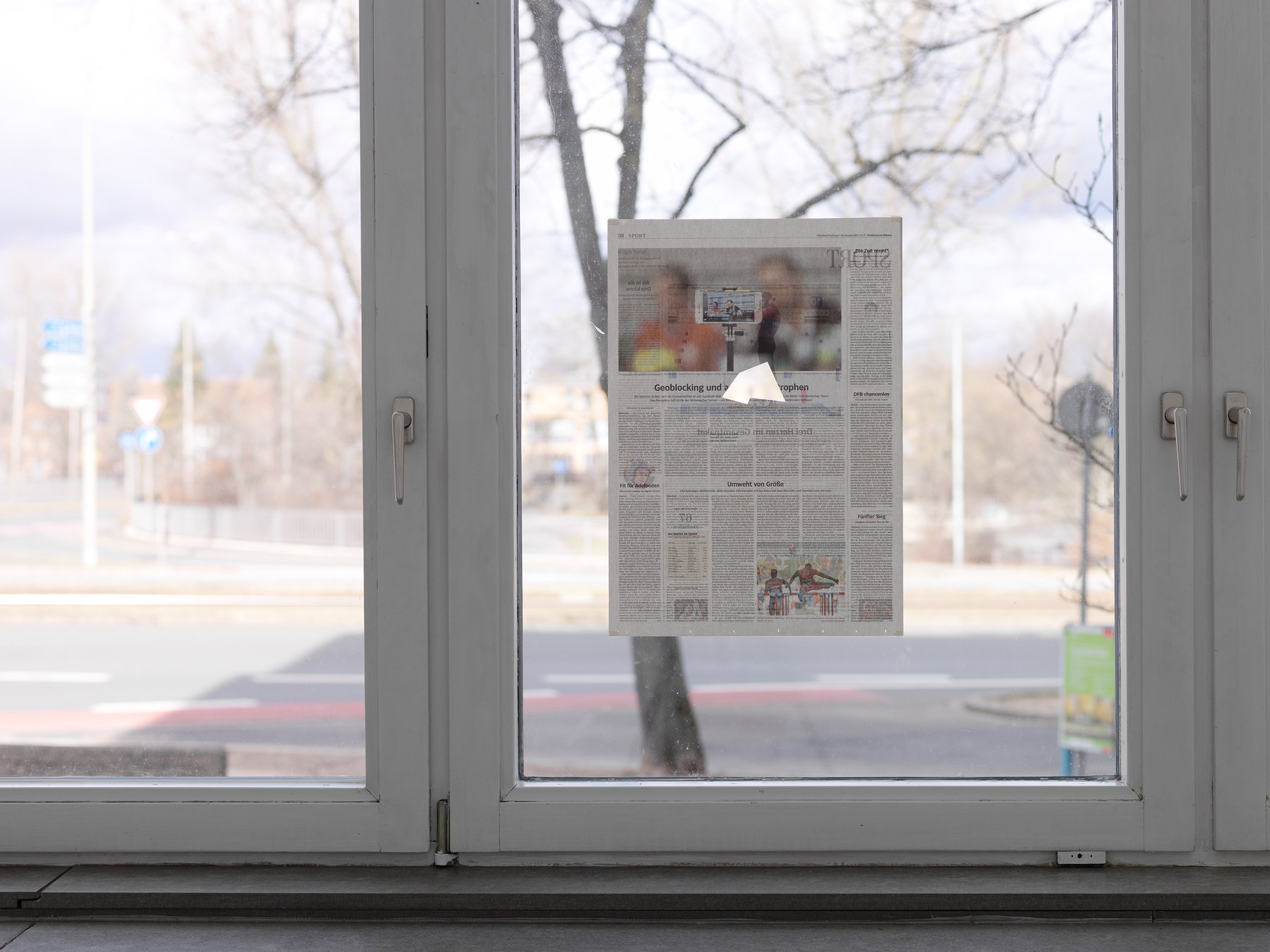Artist: Edit Oderbolz
Exhibition title: The Moon is Shining from the Left
Venue: Kunstverein Nürnberg, Nürnberg, Germany
Date: February 25 – May 14, 2017
Photography: Annette Kradisch, all images copyright and courtesy of the artist and Kunstverein Nürnberg
The Kunstverein Nürnberg – Albrecht Dürer Gesellschaft is pleased to present a comprehensive solo exhibition by Edit Oderbolz (b. 1966, Stein am Rhein, Switzerland; lives in Basel) in Germany for the first time.
With her project The Moon is Shining from the Left Oderbolz undertakes a detailed investigation into the psychological impacts that social constructions of spaces have on us. In response to a quote by architect Bernard Rudofsky – who curated the exhibition “Architecture Without Architects” at MoMA in 1964 – that folding a newspaper as protection against the sun re-enacts the birth of architecture, the artist scrutinizes the mutability of inhabited spaces between the private and the public. In her artistic practice, Oderbolz addresses architectural margins, passages and corridors as structures and drawings where both the mechanisms of security and defence as well as their repeal become legible through individual gestures and appropriation. The promises and claims of power inherent in architecture, from modernism into the digital age with their virtual designs, are challenged by Oderbolz with the dynamics of everyday use and improvisation, which are grounded in the human experience of reality.
In the large interior hall of the Milchhof building that is home to Kunstverein Nürnberg, the artist presents her installation Now Rain, Now Sun (2016), which fills the space with watermelons, folded newspapers and a fragmentary paravent on the ground. The arrangement unites objects that refer with their measurements to the human body and the actions it makes in its immediate environment. Sheets draped over an upright metal grating reveal a possible dimension of intimacy and privacy. Both the title of the work and the watermelon motif point to climatic conditions and thus the influence of nature on architectural structures. Meanwhile, the newspapers and bedsheets introduce a possible narrative oscillating between the microcosm of daily life and international political events.
In the large gallery space, the sculpture Pose is both room-filling and ethereal. Like the installation in the interior hall, this sculpture is among Oderbolz’s most recent works, which she presented in her solo exhibition at Kunsthaus Baselland last year. Now in this partner project at Kunstverein Nürnberg, the artist takes a different approach with her works in response to the exhibition spaces and the „New Objectivity“ architecture of the former Milchhof administration building, which was designed by Otto Ernst Schweizer and built in 1929-30. One of the key reference points for Oderbolz’s sculptural installation is the Bauhaus tradition and its principles of reduction, transparency and clarity, which aimed to embody the progressive claims of Modernism.
In its new formation, the object made of black iron rods bends to define the space while simultaneously opening it up to the viewers. The path of the lines sketch a figure in the space that is inspired by the architecture of the “Pedregulho”, a monumental residential complex for workers in Rio de Janeiro, designed by architect Affonso Eduardo Reidy and built in 1951-52. With its serpentine form and modular nesting of individual apartments, the complex was once celebrated as a model of “new living” with all of its social implications for the users – similar to the ideas of other Latin American architects at the time, such as Oscar Niemeyer, who developed the ideologies of European modernism in their buildings. Today the “Pedregulho” is seen as one of the city’s problem zones, showing that architecture is never neutral and cannot be conceived without regard for its inhabitants. Based on observations that she made during several stays in Rio de Janeiro, Oderbolz transfers the shape of the Pedregulho building into a skeletal structure that merges the imagination of collective experience mediated in its forms with a controlled perspective in the space.
In Doors and Windows (all 2016 and 2017), Oderbolz uses a different means of abstraction to translate spatial passages into a series of objects. As possible geometrizations of windows and doors, the objects indicate the persistent links between the internal and external world. The domestic space seems permeated by a digital public and the accelerated availability of products, as recalled by the collages made from styrofoam and cardboard packaging of computers and televisions. Circles of transparent foil are superimposed onto the surfaces, like timeless celestial bodies or panoptic eyes that observe the constellations from a distance.
In the two cabinet spaces of the Kunstverein, Oderbolz continues to explore the contours of architectural openings with reinforced steel grids attached to the walls. Such grilles are commonly used to protect the windows of a building, and are also places where the daily life of its residents becomes visible to the outside world. In the works of Oderbolz, the temporary use of objects as wardrobes, laundry stands or functional frames signals the social connotations of value and use of consumer products, which – especially in the case of textiles – indicate the globalized processes of production and distribution. As with her computer packaging motifs, here headphones refer to the growing interconnection of human beings, whereby the individual often remains in a delimited area, be it one’s own four walls or the screen of a smartphone.
In her sculptures, spatial drawings and objects, Edit Oderbolz reflects on how architectures and their inhabited structures are always part of a larger political and economic context. While utopias and powerful rhetoric can express and reveal themselves through architecture, it is only in everyday life and the lived experience that boundaries and spaces between the self and the other, between the individual and the community, can be defined and thus become tangible.
Edit Oderbolz (b. 1966, Stein am Rhein; lives in Basel, Switzerland) is known in the contemporary art context above all with the awarding of the Manor Art Prize, Basel (2004), the solo exhibition at the Kunsthaus Langenthal (2008), the project for the back wall of Kunsthalle Basel (2009/2010) as well as through her presentation at the Statements, Art Basel (2010). From October 2014 to January 2015 she received an Artist Residency in London, granted by the Landis & Gyr Foundation.
Edit Oderbolz, Now Rain, Now Sun, 2017, Installation view, Kunstverein Nürnberg
Edit Oderbolz, Now Rain, Now Sun, 2017, Installation view, Kunstverein Nürnberg
Edit Oderbolz, Now Rain, Now Sun, 2017, Installation view, Kunstverein Nürnberg
Edit Oderbolz, The Moon is Shining from the Left, 2017, Installation view, Kunstverein Nürnberg
Edit Oderbolz, Pose, 2016; Doors and Windows, 2016
Edit Oderbolz, Doors and Windows, 2016
Edit Oderbolz, The Moon is Shining from the Left, 2017, Installation view, Kunstverein Nürnberg
Edit Oderbolz, The Moon is Shining from the Left, 2017, Installation view, Kunstverein Nürnberg
Edit Oderbolz, Pose, 2016; Doors and Windows, 2016
Edit Oderbolz, The Moon is Shining from the Left, 2017, Installation view, Kunstverein Nürnberg
Edit Oderbolz, Doors and Windows, 2016
Edit Oderbolz, Ohne Titel, 2017
Edit Oderbolz, The Moon is Shining from the Left, 2017, Installation view, Kunstverein Nürnberg
Edit Oderbolz, The Moon is Shining from the Left, 2017, Installation view, Kunstverein Nürnberg
Edit Oderbolz, For the Birds, 2017
Edit Oderbolz, Unit, 2017; Doors and Windows, 2016
Edit Oderbolz, The Moon is Shining from the Left, 2017, Installation view, Kunstverein Nürnberg
Edit Oderbolz, The Moon is Shining from the Left, 2017, Installation view, Kunstverein Nürnberg
Edit Oderbolz, Unit, 2017; In the Shadow we put together a House, 2017
Edit Oderbolz, In the Shadow we put together a House, 2017
Edit Oderbolz, In the Shadow we put together a House, 2017



























